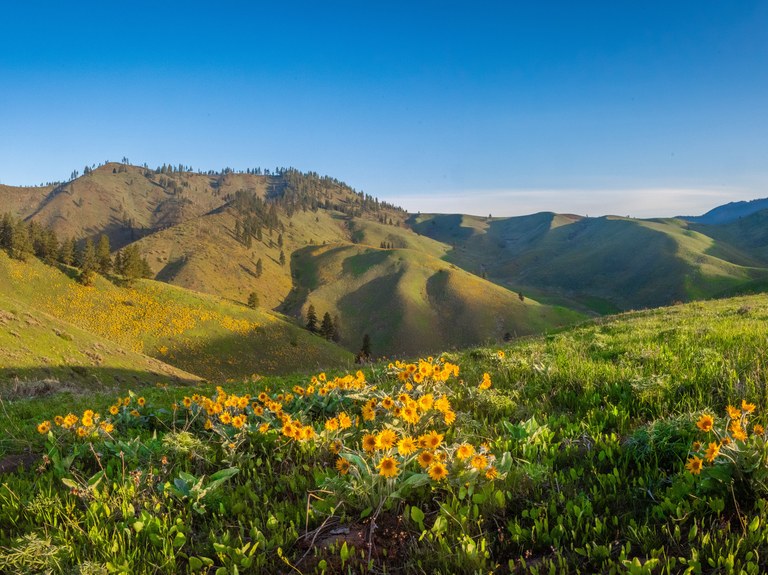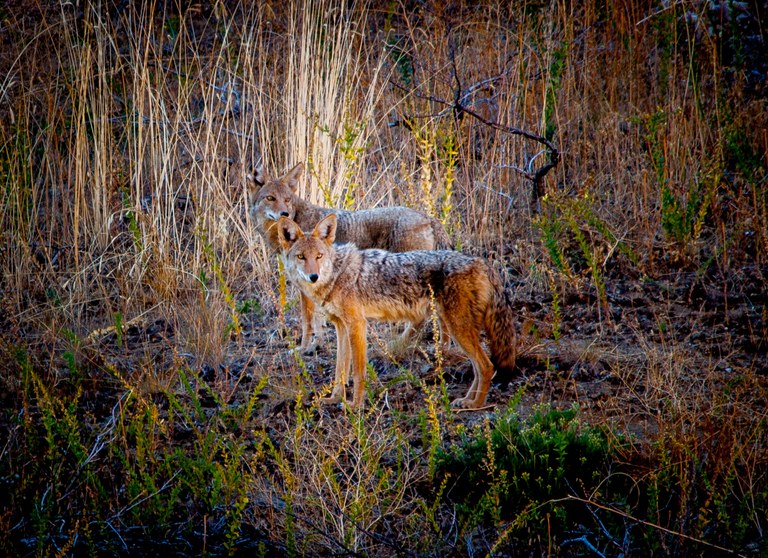Preserving Space for the Future at Cashmere Canyons
Two WTA members have helped create a preserve that allows hikers to explore 12 miles of trail in the Wenatchee Valley.
By Jill Simmons
Hikers have 12 more miles of eastern Cascades rolling hills to explore, thanks to the vision, generosity and dedication of WTA members Jabe Blumenthal and Julie Edsforth. Over 3 decades, they worked with the help of many others to create Cashmere Canyons Preserve, 2,100 acres of protected open space that is the largest undeveloped parcel of private land in the Wenatchee Valley.

Jabe and Julie enjoying the trail. Photo courtesy Jabe Blumenthal.
Cashmere Canyons’ pedestrian-only trails, which opened this spring, take hikers and trail runners through vibrant sagebrush, grasslands and woodlands and along ridgelines with stunning views of mountain ranges and river valleys. WTA sat down recently with Jabe and Julie to learn more about Cashmere Canyons, why they created the public trail system and how WTA’s community can help keep Washington’s wild places great.
WTA: What inspired you to create Cashmere Canyons Preserve?
Jabe and Julie: In the early 1990s, we came to the area to learn to paraglide. Being from the “wet side” of the Cascades, we didn’t immediately appreciate the more subtle east-side canyon landscape and ecosystem. But with every visit our appreciation of the land — its sweeping views, its importance as a wildlife corridor and its potential for incredible hiking — deepened. As the Wenatchee area was experiencing rapid population growth and consequent development pressures, we saw an opportunity to ensure wildlife and recreation had a lasting home here.
WTA: Why were publicly accessible trails an important part of your vision for Cashmere Canyons?
Jabe and Julie: The outdoors is where we go to be inspired, healed, recharged and more. We believe in the power of nature to change the way people think and feel, about our dependence on nature and our managed for wildlife habitat and environmental conservation, it seemed possible to achieve that while also giving the community the opportunity to explore and enjoy its natural beauty and experience its transformative power.
The trail system took many years to come together and would not have been possible without a strong partnership with the Chelan-Douglas Land Trust and state funding from the Washington Wildlife and Recreation Program. It’s been such a joy to see people out on the trails this spring and summer, discovering this special place.

Flowers blooming at Cashmere Canyons. Photo by David Masuda of bunkhousephotography.com
WTA: WTA’s vision for the future is trails for everyone, forever. How do you hope Cashmere Canyons supports this vision?
Jabe and Julie: We don’t think of ourselves as the owners of this land — only the Wenatchi (P’Squosa) have a legitimate claim to that — but as the current caretakers of it. If we take that role seriously, then 100 years from now, when the population of the Wenatchee Valley has doubled or tripled, Cashmere Canyons will still be a place where you can see deer and bear, cougars and coyotes, rattlesnakes and raptors, and on lucky days walk in total solitude surrounded by a sea of wildflowers, where you are neither above nor separate from nature, but fully in its midst.
Creating the preserve is the start toward that future, but it is not the end. People and institutions must come together to make intentional choices to invest in land conservation, habitat protection and recreation infrastructure. WTA’s vision of “trails for everyone, forever” won’t happen by accident or if we just follow “business as usual.”

Cashmere Canyons is a great spot for wildlife watching. Photo by Julie Edsforth.
WTA: You’re longtime members of WTA. Why do you support our work?
Jabe and Julie: It’s important for people to stop every now and then and think about the various “miracles” of civilization that we enjoy, whether it be clean water at the twist of a tap, electricity at the flip of a switch or maintained trails in protected lands. Trails and protected lands don’t happen automatically, and they aren’t free. They require sustained effort and investment by individuals, organizations and communities. What we’ve done at Cashmere Canyons is a positive but very small contribution to the much greater challenge and opportunity of environmental conservation and protected recreation lands.
We support WTA because it is an essential part of that larger effort, working with nonprofits like the Washington Wildlife
and Recreation Coalition, government agencies and outdoor recreation businesses to create lasting solutions. Everyone knows about WTA’s incredible work organizing volunteers for trail work, but just as critical is the work it does mobilizing thousands across the state to raise their voices for outdoor recreation and conservation in Washington.


Comments